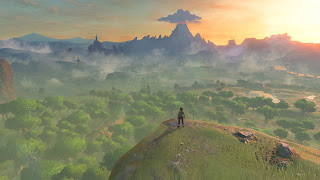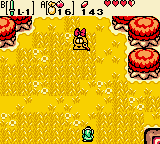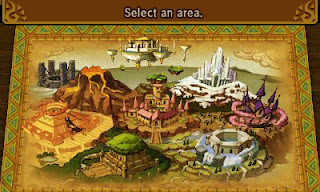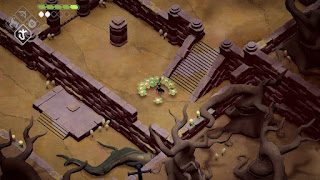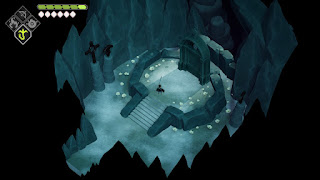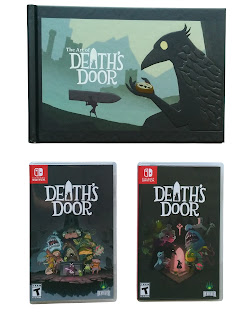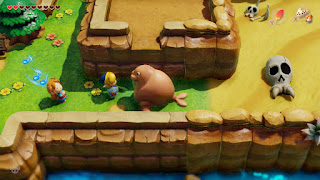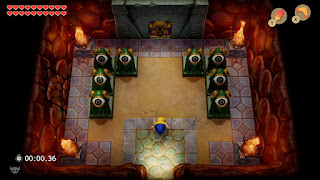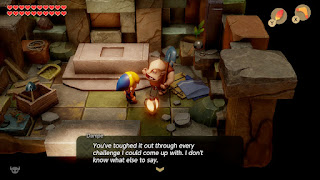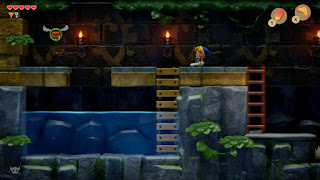In the previous post, Progression in Traditional Zelda, we have been looking at the different mechanics of how the Zelda games make you go through a series of dungeons, before you can face the final boss and finish the game. These mechanics have been an integral part of the series for 30 years, but then came Breath of the Wild and threw all of this out of the window by letting you go everywhere and do everything right out of the gate.
The Great Plateau
Actually, this isn't entirely true, because the game's tutorial still employs some of the traditional progression mechanics. You can't leave the plateau until after you've obtained the Paraglider. And this isn't just because you're missing the item, but because the game surrounds the area in a deadly fog and won't even let you climb down to the rest of Hyrule. You are trapped there by design. (Well, you can get off with Stasis, but this is not intentional.)
And in order to get the Paraglider you will have to clear the four Shrines on the Great Plateau first, where each of them gives you a Spirit Orb. The Old Man wants you to collect these orbs, so they are basically your traditional Triforce Shards at this point. And the Sheikah Shrines are your need-to-clear dungeons, where you get all the main items of the game in the form of the Sheikah Slate Runes. It's just that these dungeons are much smaller, where the Great Plateau feels like a "mini Zelda game" overall. But this is what makes it one of the most special tutorials ever made.
Once you've left the Great Plateau, you will have all the tools needed to clear the game and the freedom to go wherever you want. So, what's stopping you from just running over to Hyrule Castle to give Calamity Ganon a beating? Well, nothing really, only your own skill...
Progression Based on Strength
You will only get as far as you're able to get past the enemies. This is all there is to and a concept that's not completely new to the series... In fact, the first The Legend of Zelda also did this for the most part. While you could theoretically go right into Level 8 from the beginning of the game, the monsters there will surely give you a hard time. And already on the overworld you may not be able to go everywhere because of some stronger monsters, like the Lynels around Death Mountain.
Breath of the Wild embraces this idea. Right before leaving the Great Plateau you're given the quest to "Destroy Ganon" and you can go just do that. However, you will have to get past by multiple Guardians and beat all four Blights in the throne room of Hyrule Castle, who are protecting Calamity Ganon with what's essentially a boss rush. With only three or four hearts this is extremely challenging and something that only the most experienced Breath of the Wild players will take on.
Your best course of action is to go elsewhere first, where you're also told to seek out Impa for additional directions. She will then guide you to the four Divine Beasts, which are the main dungeons of this game. Clearing a Divine Beast will reward you with the respective Champion's signature ability, but it will also remove the corresponding Blight from Hyrule Castle and take 12.5% off from Calamity Ganon's health during the decisive battle.
So, it all will make things easier for you in various ways. And on your journey you will find additional Sheikah Shrines for more Spirit Orbs, which can increase your heart meter or your stamina wheel. You will also find Korok Seeds, which can be used to upgrade your inventory space for more weapons. And you will obtain better armor to protect you from damage or different environmental hazards. With every step you slowly will grow stronger and more confident in taking on challenges, like facing the tough Lynels.
This was also true for the Lorule part of A Link Between Worlds, where the dungeons gave you items like better armor, more stamina, or ore to temper the Master Sword. All of those are important steps of becoming stronger, other than collecting more Heart Containers and Maiamais. But for the most part it didn't really matter in what order you took on the dungeons, except for the more difficult Ice Palace and maybe Turtle Rock.
It's the same problem with Breath of the Wild, where Vah Naboris stands out a bit, but the other Divine Beasts are around the same difficulty level, since you should be able to play them in any order. It all feels pretty much the same.
The rest of the game also employs level scaling, where certain enemies upgrade based on how many foes you've already defeated. This goes against your progress in certain areas, where you may feel like you're not getting stronger at all, simply because the game is holding against it...
The Loadout
The freedom of going everywhere right after the Great Plateau came with a price: there is no progress based on new abilities, like you would have in any classic Zelda or Metroid title. You get all the main items at the beginning of the game – the Paraglider and the four Sheikah Slate Runes: Magnesis, Bombs, Stasis, and Cryonis. And this is everything you need to overcome every obstacle and to solve every puzzle in the game.
As a result there is zero backtracking afterwards, but you also won't get the satisfaction of "I can now do this". You won't have a mental map of all the secrets and places you couldn't reach so far without the Bombs or the Hookshot, which kicks in once the needed item is finally obtained. Not everyone likes this, of course, where it can be seen as padding and some players just don't want to revisit areas. For them Breath of the Wild certainly has improved things, while for others there is something missing that has been part of the DNA of Action Adventures.
But let's do a thought experiment here. How would Breath of the Wild play out if it only gave you the Paraglider on the Great Plateau? All the main Sheikah Slate Runes have to be obtained from the Divine Beasts in this scenario:
- Cryonis in Vah Ruta
- Bombs in Vah Rudania
- Stasis in Vah Medoh
- Magnesis in Vah Naboris
Ignore for a moment that you need these abilities to enter the respective Divine Beast in the first place, except for Stasis. The game would be changed accordingly.
The Sheikah Shrines could work similarly to the mini dungeons in A Link Between Worlds, where they will tell you what runes are required in order to clear the trial. Even if you don't have the necessary runes yet, you will have gotten a warp point and can quickly return there later. It already works like this with the different Tests of Strength and the strength-based progression. If one of these Guardian Scouts are still too difficult for you, you may battle it later. So, with the shrines this isn't much of an issue.
Still, in a game world of the scale of Breath of the Wild this causes problems left and right: no matter where you go, you will have to leave something behind. All these sunken chests in the water? You can only mark them on your map for later. All the puzzles where you have to move a heavy object? You can only mark them on your map for later... And before you see it you're out of markers.
With Bombs this would actually not be an issue, because they can be substituted with hammers, a Drillshaft, Bomb Arrows, or similar consumable items. Having Bombs would simply be more convenient in the end, because you always have them available, but it would also not give you the "I can now do this" effect of getting the Bomb Bag in Ocarina of Time for example.
Cryonis could technically be substituted with Ice Arrows if they worked anything like in Majora's Mask (or the Trine games). You can also try to move the swimming chests towards land, but it wouldn't be much fun and very inconvenient.
The powers of Magnesis can't be replaced and Stasis only to a small extent, so as long as you don't have these two items, you will be missing out eventually, especially with Magnesis. It's part of the reason why this rune is given to you in the first Shrine you will see, because otherwise there already would be quite some backtracking on the Great Plateau with all the chests found underwater. It may not be much of an issue there, but it certainly would be in the full scale of the game.
Progression in Tears of the Kingdom?
So, how might the sequel change things? Will it even change things? Well, there are a lot of loud voices within the Zelda community who would like to see traditional dungeons and ways of progression back. The fact that we may have to repair the Master Sword in some form could already be a hint that the game may shy away from the sole strength-based approach of Breath of the Wild.
Here you could face Calamity Ganon at any time after the Great Plateau. There is nothing else needed other than some weapons and your skill. But in Tears of the Kingdom it may be necessary to restore the Master Sword before you can face Ganondorf, like it was the case in The Wind Waker.
You may also have a classic main quest collectible with the tears, but this could also be a way of improving Link's abilities and be related to the vials that he is carrying. We will probably learn more soon...
However, there is something that will feel more natural in the new environments: areas that can't be reached at first. You should be able to traverse and explore the Hyrule from Breath of the Wild in the same fashion, but the world will get expanded upwards and potentially also downwards. And there may be sky islands that are simply too high up at first. Or you might find caves with dead ends.
Since these are just small chunks within the world and you probably will have plenty of warp points again, it could work as something where you need to find certain items first, like in classic Zelda games. But we will see.

